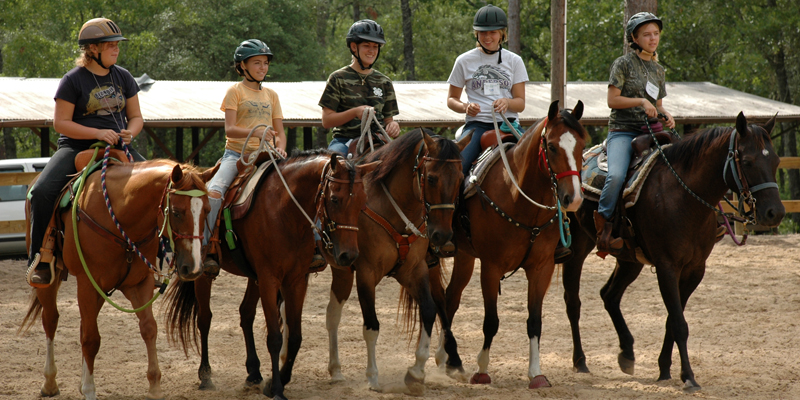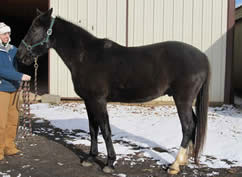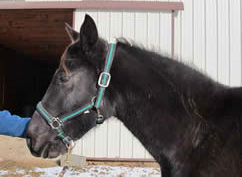Brooks Equine Genetics Lab
Gait Study

Project Description
In order to discover which genes are responsible for gait in horses, we need gaited horses! The goal of this study is to identify which genes predispose horses to trot, pace, running walk, rack, fox trot, tolt, paso, etc. We need horses from all of the gaited breeds and any crosses with gaited breeds. And we need hundreds and hundreds of horses; the more horses that participate, the more successful our study will be.
- For the gait study, from each horse we are collecting:
- Short video of the horse walking and gaiting
- Pulled tail or mane hair (blood if possible)
- Copy of the pedigree
- Full body conformation picture and profile head picture
34 different body measurements - Information on the shoes and uses of the horse
Information on the horse’s behavior and temperament - Horses need to be at least one year old. Horses do not need to be registered, but we do need the names of the sire, the dam, the grand sires, and the grand dams.
-
Intro / Background
Have you ever wondered why gaited horses gait? Why some gaited horses can trot or pace and gait? What is it about the gaited breeds that makes them so unique?
The purpose of this study is to answer all of these questions! We will discover what makes a gaited horse gait by looking at the blueprint of life for all creatures: DNA. Horsemen have known for years that a trotting horse cannot be trained to gait; the only way to get a gaited horse is by breeding other gaited horses. There is something that gaited horses are inheriting from their parents – the genes to gait.
Genes are regions of DNA that code for a specific biological function or characteristic, such as hair color, blood type and number of fingers. Genes have different variants known as alleles; these are responsible for the differences we see among individuals. For example, everyone has the gene responsible for eye color, but some have the allele for blue eyes and others have the allele for brown eyes. The alleles have different sequences of nucleotides or bases, the basic building blocks of DNA. There are four bases: adenine (A), guanine (G), cytosine (C), and thymine (T). Strung together in different combinations of a long chain, the bases provide the code for reading DNA and subsequently the genes.
Genes are packaged and stored together in chromosomes, which are stored in the nucleus of cells. All mammals have two copies of each chromosome, but the total number of chromosomes varies according to species. Humans have 46 chromosomes, horses have 64, donkeys have 62, and mules have 63. One copy of each chromosome is passed from each parent to the offspring; in the case of the mule, they inherit 32 chromosomes from the horse parent and 31 chromosomes from the donkey parent leading to the grand total of 63 chromosomes. One set of chromosomes, along with all the genes, is collectively known as the genome. In 2007, the horse genome was sequenced to reveal a 2.7-billion nucleotide long genome. With the genome sequenced, it is now possible to find genes and map them to a specific location on a chromosome.
Due to the complex nature of gait, we hypothesize that there are multiple genes involved with gait. Gait is influenced by the conformation and neurobiology of the horse, and to some extent, human intervention in the form of shoeing and training. Each of the physiological aspects are influenced by several other components. Conformation is impacted by bone length and thickness, muscle mass, and shoulder and hip angles. Nerve types, calcium and potassium concentrations, and synapse receptors and transmitters control the neurobiology. Several genes influence each of these components; therefore, it is unlikely that just one gene is responsible for gait, but rather a specific combination of genes and their alleles produce the various gaits.
-
Measurements and Pictures
The 34 body measurements cover lengths and circumferences of the horse’s head, neck, body and legs. The measurements are used to capture the conformation and bone size of your horse. Conformation plays an important role in determining gait; therefore we want to use the measurements to find any correlations between gait and conformation. For detailed instructions on how the measurements are taken, please click view the video below:
The conformation pictures allow us to calculate the hip and shoulder angle, and determine whether your horse has a dishy, flat, or roman nose. The pictures should be of the horse standing square and in profile. Please do not send only pictures of the horse looking at the camera; while those are more attractive pictures, the pose makes our calculations more difficult to compute.
Below are examples of what we are looking for in the conformation pictures.


-
Hair and Blood
Hair and blood samples are used to obtain your horse’s DNA. Using different protocols, DNA can be extracted from the blood and the hair bulb. Blood yields more DNA with a higher purity than hair, but DNA survives longer in hair stored in manila envelopes than blood stored in the freezer. Once the DNA is extracted, the unique genome of your horse is available to be tested to help find the genes involved with gait.
Note: Blood typing and DNA markers for breed registries also use your horse’s DNA to identify your unique horse, but the DNA markers are not genes. The markers are repeats in the DNA sequence at specific points, essentially mile markers, which confirm parentage and when the markers are combined create a fingerprint unique to your horse.
Please pull hair from the tail or mane. Do not send hair from a brush as these hairs may be damaged or contaminated from another horse.
-
Video
Video
The video of your horse walking and gaiting does not need to be very long and can be taken with a digital camera in movie mode. The horse can be either led or ridden or both. The most important factors of the video are being able to see all four feet, for footfall timing, and the head for the presence of a nod.
For the walk, and each intermediate gait the horse can perform, we just need 10 seconds or at least 5 strides of the following views:
Under Saddle Examples:
In Hand Examples:
-
Behavior
During our research into gait, we have observed a difference between and in gaited vs. non-gaited horses that we believe is due to temperament. For example, genetic tendencies may contribute to the suitability of a horse for trail-work rather than performance classes, or may alter how the horse responds to a training program.

Contact
SAMANTHA BROOKS
Associate Professor, Equine Physiology
samantha.brooks@ufl.edu
